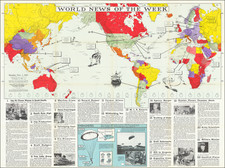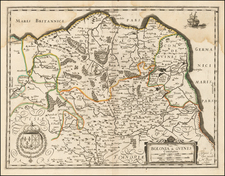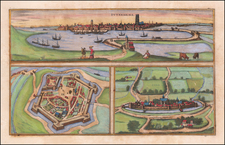The U.S. Army's Contemporary Day-by-Day Mapping of the Siege of Bastogne. Exceedingly Rare.
Exceptional set of maps of the Siege of Bastogne produced by the 664 Engineer Topographic Corps and vividly portraying the unrelenting violence faced by the American forces during the battle.
The story of the battle is well-known, and its pivotal events have been extensively studied by military historians who saw it as one of a few possible breaking points in the Allied front. These maps, published less than a month after the siege was lifted, provide an unparalleled cartographic insight into the progress of the war and are some of the most near-contemporaneous printed battle maps to appear during the conflict.
All of the maps have the same base. The first eight maps depict the daily progress of events from December 19th to the 26th, while the events of the 27th through 31st are compressed on a single sheet. The design of the maps is striking: on the one hand they are minimalist in limiting geographic information to the tracks of roads and the locations of villages and towns; on the other, each sheet depicts the movements of dozens or hundreds of American (blue) and German (red) infantry, mechanized, and artillery units. Blocks of text describe events hour by hour, even for very small units. One of the more interesting features is the use of symbols to represent combat units: the abstract and highly-standardized iconography used by the Army is complemented throughout by the use of informal pictorial elements to represent bombardments, airdrops, tanks, and so on. This is particularly the case from the 23rd of December onwards when the skies begin to fill with tiny blue American planes.
This collection of the maps is interesting as it has additional pastedowns on the first sheet showing the events of the 19th of December. These name the American and German commanders in charge of various units on that day and include further information on German units involved.
The maps are dated January 1945, which implies that somehow they were compiled and printed within no more than five weeks of the battle, an amazing feat given the chaotic circumstances and the complexity of the events depicted. They were produced by 664 Engineer Topographic Corps, which was attached to Patton’s massive Third Army. Unfortunately I have been able to find only the most rudimentary information on the unit, though OCLC does record a few maps bearing its imprint. The unit’s best-known output, however, was 250,000 copies of a Christmas greeting and prayer card from Patton, run off by pressmen working day and night and distributed throughout the Third Army on December 12-14, 1945.
In all, this collection represents a remarkable record of one of the most ferocious battles of the European Theatre of the Second World War.
The Battle of Bastogne
Bastogne was a critical turning point in during the Battle of the Bulge, in which an outmanned and outgunned American forces held out in the town of Bastogne for six days before relief arrived. This defensive maneuver by the 101st Airborn and other units effectively halted advancing German forces at a critical point in the wider offensive, thus ending the last hopes for German stalemate on the western front.
The Battle of the Bulge was was launched in December 1944, and aimed to split the Allied forces and capture the port of Antwerp in Belgium. The battle raged for over a month and resulted in the highest number of American casualties of any operation during World War II. One of the primary objectives of the German offensive (Operation Wacht am Rhein) was to capture the town of Bastogne, which was located at a critical crossroads in the Ardennes forest.
Between December 19th and December 21st, German forces surrounded Bastogne, encircling the American 101st Airborne Division and elements of the 10th Armored Division. Despite being heavily outnumbered and low on supplies, the American forces put up a fierce resistance and held their ground, which prevented the Germans from achieving their objective of taking the town and advancing further west. The siege was eventually broken by a combined force of American and British troops, which lifted the siege and forced the Germans to retreat when they ran out of fuel. The battle resulted in significant casualties on both sides and is considered a major turning point in the European theater of the war.
Rarity
This set of Bastogne maps is of the greatest rarity. We are aware of complete sets only at the National Archives and Texas A&M, with no further sets having passed through the market.












![[Paris Environs - Southeast] Carte Routiere pour Automobilistes & Cyclistes -- Environs de Paris Section Sud-Est](https://storage.googleapis.com/raremaps/img/small/95862.jpg)


![(First state!) [ Rhine River Valley ] Tertia Rheni Nova Tabula](https://storage.googleapis.com/raremaps/img/small/96984.jpg)
